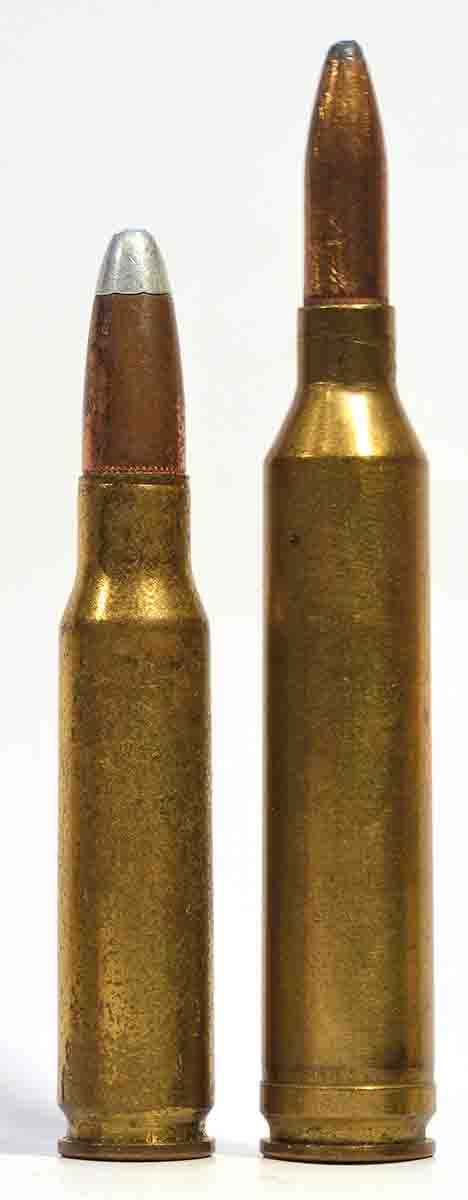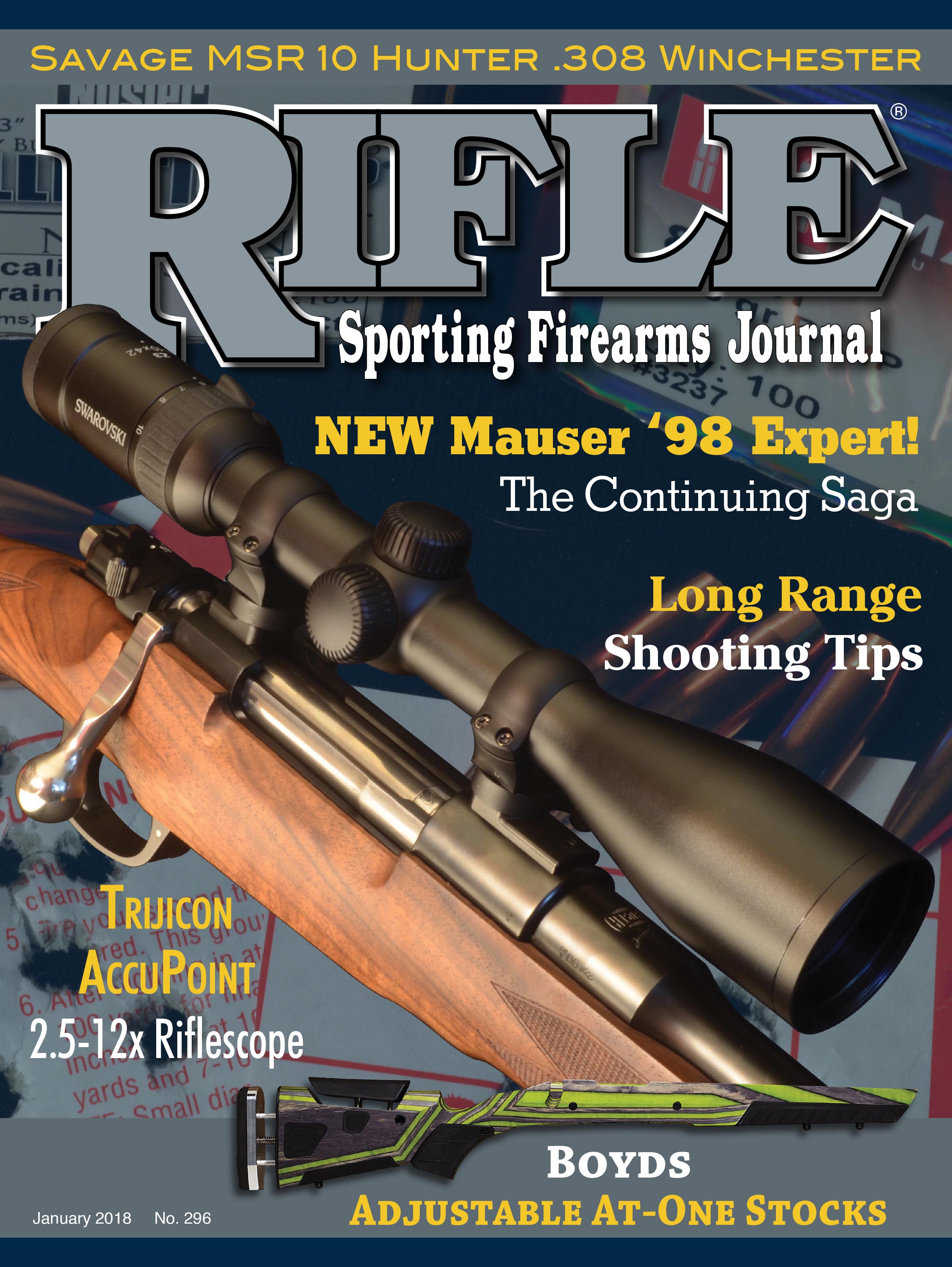Walnut Hill
Requiem for a Featherweight
column By: Terry Wieland | January, 18

In the 1965 Gun Digest, the new line was examined by three prominent writers: Ken Waters, Bob Hagel and Pete Kuhlhoff. Waters and Hagel would go on to become stalwarts of Rifle’s writing staff for almost 40 years; Kuhlhoff was gun editor for Argosy, a prominent (and respected) general interest magazine for men.
Hagel compared an old Model 70 with a new one, both in .300 Winchester Magnum, shot head-to-head with the same batches of ammunition. Kuhlhoff’s purpose was to review what was new that year, while Waters was given the job of test firing the new stuff.
Viewing one especially notable change to the Model 70 lineup, Waters observed “the Featherweight has happily been abandoned . . .” Happily? Why happily? That is a little mystery that requires some digging.
In 1963, the Model 70 Featherweight was only 11 years old, a very recent addition to a line dating back to 1936. In that decade, however, Winchester had managed to take a superb idea, and a marketing triumph, and screw it up royally. There is really no other way to put it. The engineer at Winchester who dreamt up the Featherweight in the first place – his name having been lost to history – probably resigned in disgust.
To understand what happened, we have to go back to the summer of 1952 and a joint announcement from Winchester of both a new cartridge and a rifle specifically designed for it. The cartridge was the .308 Winchester, a civilian version of the then-new military 7.62x51 NATO (T-65). Winchester had to get permission from the army to do this, and it was a big deal.
Maj. Gen. Julian S. Hatcher, reviewing the development in the 1954 Gun Digest, paid more attention to the cartridge than the rifle, which made use of a Ball powder developed by Olin, Winchester’s parent, for the M1 Carbine. It allowed the smaller .308 case to match the original performance of the .30-06 (150-grain bullet, 2,700 fps). It was a ballistic breakthrough, and the hunters and shooters of America would benefit.
Winchester’s rifle for the new cartridge was no less notable. The company took the Model 70 and put it through extensive reengineering just to match it to the cartridge. The most notable change was a free-floating barrel that was shorter (22 inches) and had a narrower profile. The integral boss, which provided a platform for the rear sight, was gone, as was the barrel-tension screw. With the barrel-tension screw gone, the barrel could be free floated its entire length. This was a term that gained considerable currency over the next several decades.
The Model 70’s steel bottom metal was replaced with aluminum alloy. This was usually referred to as “duraluminum,” or simply “dural,” which has caused some confusion. It did reduce weight. The stock was trimmed back by about an inch on the forend, which gave the rifle a cohesive appearance. It was advertised as weighing 6.5 pounds, although Hatcher said the samples he handled ran slightly heavier.
This brand-new, ground-breaking rifle was offered in just one cartridge, the new .308 Winchester. They were literally made for each other.
During the preceding five years there had been an increasing demand from writers and the public for rifles that were smaller and lighter, and the Featherweight was Winchester’s response. It was a major change for American gunmakers and exerted enormous influence. It should have been Winchester’s greatest postwar triumph. So why, 11 years later, did Waters say it had been abandoned?

One can simply imagine the committee meetings of engineers, managers and marketing people after the Featherweight sprang on the scene. The new .308 cartridge was greeted with hosannas and has never looked back. But the Featherweight? Well, there’s the rub. Seeing the success of its new baby, Winchester very quickly offered it in both .270 Winchester and .30-06. When the .243 Winchester came along in 1955, it was added to the list. So far, so good – or at least, not all that bad.
For the Featherweight, the absolute low point – the date in history when it was subjected to the ultimate indignity – was in 1961, when Winchester announced it would henceforth be offered in the new .264 Winchester Magnum. The .264 was one of the original “short magnums” with a belted case. It was Winchester’s answer to demands for a small-bore, ultra-high velocity, long-range rifle for the plains.
The company needed a cartridge to counter Weatherby’s hotshots and Philip Sharpe’s 7x61 Sharpe & Hart, and the .264 Winchester was it. It fired a 140-grain bullet at a reported 3,200 fps and a 100-grain bullet at 3,700 fps. This is all well and good. With the powders of the day, however, such a cartridge required a minimum barrel length of 26 inches to come anywhere near delivering these velocities.
The mating of the .264 to the Featherweight was announced at the 1961 Winchester writers’ conference, in conjunction with a couple of other changes, as reported by Gun Digest Editor John Amber. To try to make its barrels more uniformly accurate, Winchester said it was adopting a revolutionary new barrel-making technique pioneered in Europe, called hammer forging. The first barrels made this way in New Haven would be in the shiny new .264 Winchester Magnum. What was more, they would be made of stainless steel, 22 inches long and destined for fitting into a new variation of the Featherweight.
Amber and his colleagues (as he admitted) had to accept some of the blame, since they had generally agreed that a 26-inch barrel was simply too long for a rifle to be carried in the mountains. At the same time Winchester announced a new type of recoil pad for the .264 Featherweight. No details were released since the pad was top secret, but Winchester knew what it was creating.
Pairing the red-hot .264 with a 6.5 pound rifle with a 22-inch barrel turned the stylish Featherweight into a bucking, booming, fire-breathing monster. And yet the end product of all this Sturm und Drang would be a muzzle velocity so far short of advertised velocity that it hardly matched the .270 Winchester.
Amber took one of the .264 Featherweights to Wyoming in 1961 to hunt elk. He reported that his handloads, measured with an Avtron chronograph, achieved 3,050 fps with a Nosler 140-grain Partition. Considering you could get 3,130 fps with a 130-grain bulet in a .270, it was hard to see an improvement.
With the great Model 70 redesign of 1963, the Featherweight was swept away, but the Standard model was altered to such an extent that it looked like the old Featherweight in all but name. Weights were listed as 7 pounds and up. Gone was the original, 6.5- pound, .308 Winchester. The Featherweight name did not return to the Model 70 lineup until 1981.
I’m not sure what all of this means, except that it is further proof that companies who make a good thing seem incapable of leaving it alone and letting it prosper. For my part, I would like one day to have the chance to handle one of those original 1952 Winchester Model 70 Featherweights in .308 Winchester. It must have been a gem of a rifle.


